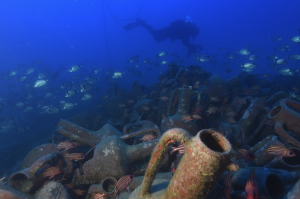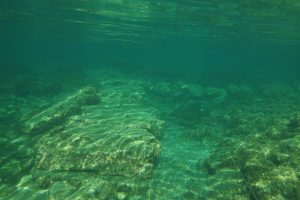Mare Cyprium: Multimedia Applications for Cypriot Maritime Cultural Heritage

Dr Massimiliano Secci and Dr Stella Demesticha
Since its establishment in 2011, the MARELab, University of Cyprus (UCY), has been testing numerous digital techniques for the documentation, study and dissemination of the island’s maritime cultural heritage. Excavations have been carried out at the Mazotos (4th century BC) and Nissia (Ottoman period) shipwreck sites. Research has also been conducted on ships and shipbuilding of the recent past, such as the digital recording of the 20th century wooden trawler ship AGIOS SPYRIDON, as well as local types of smaller fishing boats. Moreover, surveys are currently being carried out on the submerged Hellenistic harbours of Amathous and Paphos.
The main idea behind the Mare Cyprium Project is to build on existing digital data that can be integrated in multimedia applications, to promote the Maritime Cultural Heritage (MCH) of Cyprus. A series of digital products will be created, aiming to facilitate accessibility and foster appreciation of MCH, so that non-specialists understand its significant contribution to the history of the island and the eastern Mediterranean. The multimedia digital applications will address a wide range of audiences, while particular attention will be given to ensure wide accessibility to the final deliverables. The project will also establish synergies with the HFF’s Google Arts and Culture profile and with similar initiatives developed by other countries in the HFF Region.

Digital media will be utilised to convey information and knowledge on diverse themes – ships, shipwrecks and harbours, through the following sites:
1. The Mazotos Shipwreck, a 4th century BC site, whose excavation started in 2010 and is still ongoing
2. The Nissia Shipwreck, an 18th century AD site, where two excavation seasons have revealed a part of its hull and at least three cannons
3. The Hellenistic – Roman Harbour of ancient Paphos. The site has been investigated in the 1990s and MARELab has just undertaken a pre-construction survey, which include extensive digital mapping and documentation.
4. The Hellenistic Harbour of Amathous. The site, excavated in the 1980’s and fully published recently, will soon be digitally recorded by MARELab, as a deliverable of the ANDIKAT Project.
5. The AGIOS SPYRIDON Trawler. The ship has been dismantled in a controlled way and fully digitally recorded by MARELab, during two seasons in 2018-2019.
6. The MARELab Collection of fishing boats. Six traditional Cypriot boats are kept at the storage facilities of MARELab/UCY, and have already been partially recorded during seminars with under- and post- graduate students.

Multimedia applications will promote specific information that archaeologists extract from each site or ship, but also fieldwork procedures of maritime archaeology itself. For the selection of the most appropriate dissemination strategies and applications, Mare Cyprium will capitalise on the experience acquired from the EU-funded iMARECULTURE and ANDIKAT projects, both of which have made extensive use of digital tools and have developed promotion strategies through these media. iMARECULTURE used advanced augmented and virtual reality technologies to develop applications such as dry visits, interaction with specific artefacts, and serious games, whereas ANDIKAT focused on the development of a cultural itinerary at Amathous harbour, employing both land-based, underwater and digital interpretive tools. Mare Cyprium will also benefit from collaboration with the Nautical Archaeology Society (NAS), in particular concerning public outreach and dissemination strategies, audience profiling and segmentation as well as product(s) launching and audience’s engagement evaluation.
The goal is to raise public awareness about maritime archaeology, by addressing some of its integral domains, such as:
1) Interdisciplinary approaches, procedures, technologies, and methodologies used in maritime archaeology.
2) Protection and preservation of the maritime cultural heritage.
3) Ancient and vernacular ships and shipbuilding.
4) Harbours, seaborne trade, and maritime economies of the past.
